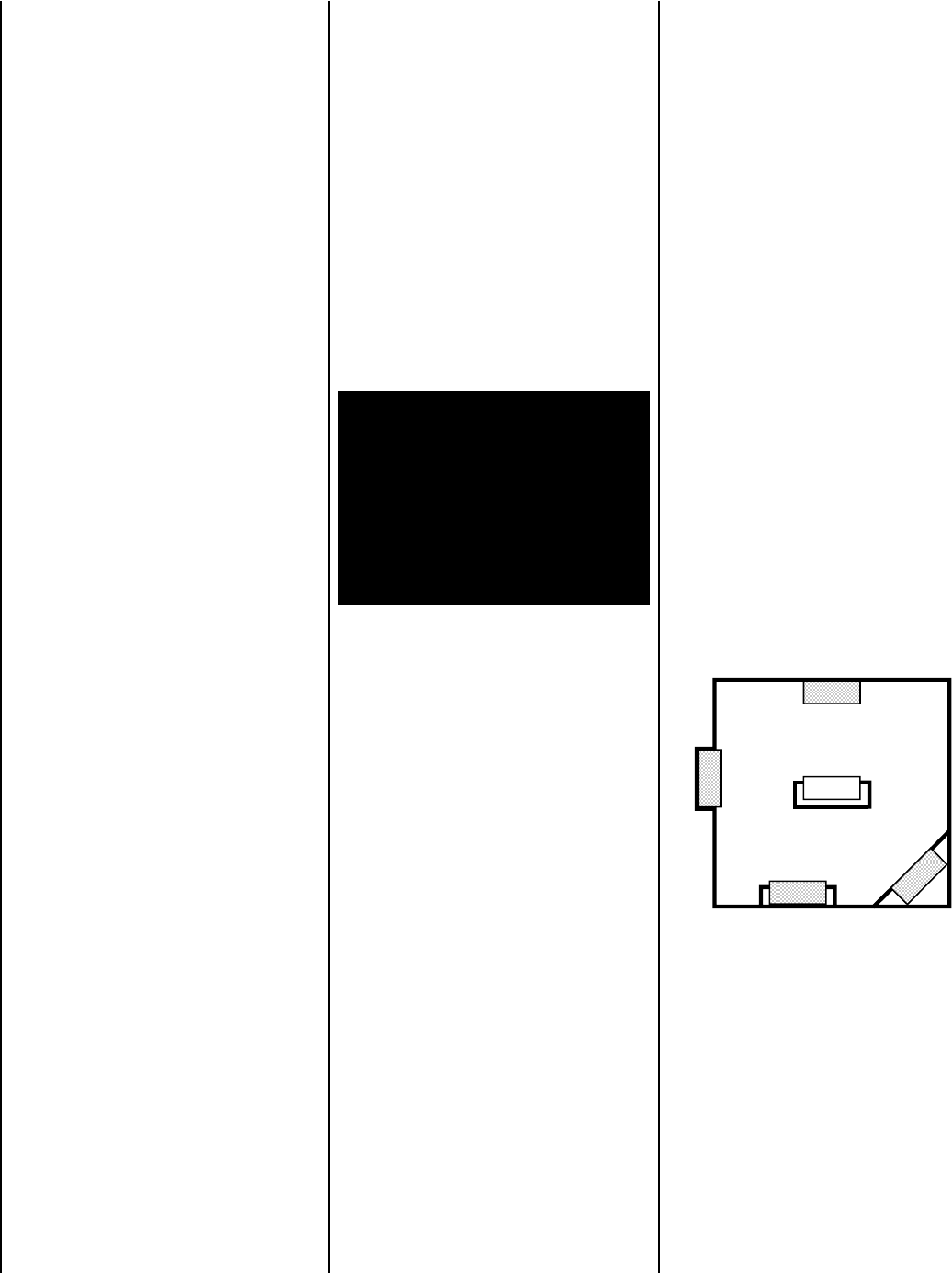
NOTE: DIAGRAMS & ILLUSTRATION NOT TO SCALE.
4
Figure 1
To ensure even heat distribution, it is best to
position the heater centrally against the long-
est wall of the room. Make sure there is ad-
equate ventilation where the heater is installed.
The gas appliance will shut off if the oxygen
level falls below 18.0%.
These appliances are uniquely suited for in-
stallations requiring a utility shelf positioned
directly above the fireplace. Utility shelves like
these are commonly used for locating televi-
sion sets and decorative plants.
Your options are:
a.Rework equations adding the space of ad-
joining room(s). If the extra volume provides
an unconfined space, then remove door or
add ventilation grills between rooms. Refer
to National Fuel Gas Code, ANSI Z223.1
1992, Section 5.3.
b.Vent room directly to the outdoors. Refer to
National Fuel Gas Code, ANSI Z223.1 1992,
Section 5.3.
c. Install a lower BTU/Hr heater, such as the
25,000 BTU/Hr, to make the area an uncon-
fined space.
If the actual BTU/Hr used is less than the
maximum BTU/Hr the space can support, then
the space is an unconfined space. You will need
no additional fresh air ventilation for an uncon-
fined space.
LOCATION OF FIREPLACE
Carefully select the best location for installation
of your VF5000 and VF6000 series Unvented
Room Heater. The following factors should be
taken into consideration:
• Clearance to side wall, ceiling, woodwork
and windows.
• Location must not be affected by drafts
caused by kitchen exhaust fans, return air reg-
isters for forced air furnaces/air conditioners,
windows or doors.
• Installation must provide adequate ventila-
tion and combustion air.
• Do not install the VF5000 and VF6000 series
heaters in a sleeping room or bathroom.
• Never obstruct the front opening of the
heater or restrict the flow of combustion and
ventilation air.
• This appliance may be installed in an after-
market manufactured (Mobile) Home, where
not prohibited by state or local codes.
*Aftermarket: Completion of sale, not for pur-
pose of resale, from the manufacturer.
• Minimize modifications to existing construc-
tion. Refer to
Figure 1
for location suggestions.
4. Compare the maximum BTU/Hr the space
can support with the actual amount of BTU/
Hr used.
_________ BTU/Hr
(max. the space can support)
_________ BTU/Hr
(actual amount of BTU/Hr used)
Example:
61,440 BTU/Hr
(max. the space can support)
66,000 BTU/Hr
(actual amount of BTU/Hr used)
The space in the above example is a confined
space because the actual BTU/Hr used is more
than the maximum BTU/Hr the space can sup-
port. You must provide additional fresh air.
WARNING: IF THE AREA IN WHICH THE
HEATER MAY BE OPERATED IS SMALLER
THAN THAT DEFINED AS AN UNCON-
FINED SPACE, PROVIDE ADEQUATE
COMBUSTION AND VENTILATION AIR BY
ONE OF THE METHODS DESCRIBED IN
THE NATIONAL FUEL GAS CODE, ANSI
Z223.1 1992, SECTION 5.3 OR APPLI-
CABLE LOCAL CODES.
Unusually tight construction is defined as con-
struction where:
a. wall and ceilings exposed to the outside
atmosphere have a continuous water vapor
retarder with a rating or one perm or less with
openings gasketed or sealed, and
b. weather stripping has been added on oper-
able windows and doors, and
c. caulking or sealants are applied to areas
such as joints around window and door frames,
between sole plates and floors, between wall-
ceiling joints, between wall panels, at penetra-
tions for plumbing, electrical, and gas lines,
and at other openings.
Use the following equations to determine if
you have a confined or unconfined space.
1.Determine the volume of space — ft
3
.
Length x Width x Height = _____ ft
3
(Include adjoining rooms with doorless pas-
sageways or ventilation grills between
rooms.)
Example: 24' (L) x 16' (W) x 8' (H) = 3072
ft
3
2.Divide the volume of space by 50 ft
3
to
determine the maximum BTU/Hr the space
can support.
______ (volume of space – ft
3
)/ 50 ft
3
=
(Maximum BTU/Hr the space can support)
Example: 3072 ft
3
/ 50 ft
3
= 61.44
or 61,440 BTU/Hr the space can support.
3.Add the BTU/Hr of all the fuel burning appli-
ances in the space.
Vent-Free heater _______ BTU/Hr
Gas appliance #1* _______ BTU/Hr
Gas appliance #2 + _______ BTU/Hr
Total = _______ BTU/Hr
Example:
VF6000 Vent-free heater 32,000 BTU/Hr
Gas appliance #1 34,000 BTU/Hr
(water heater)
Total = 66,000 BTU/Hr
* Do not include direct-vent gas appliances.
Direct-vent is sealed combustion and draws
combustion air from the outdoors.
